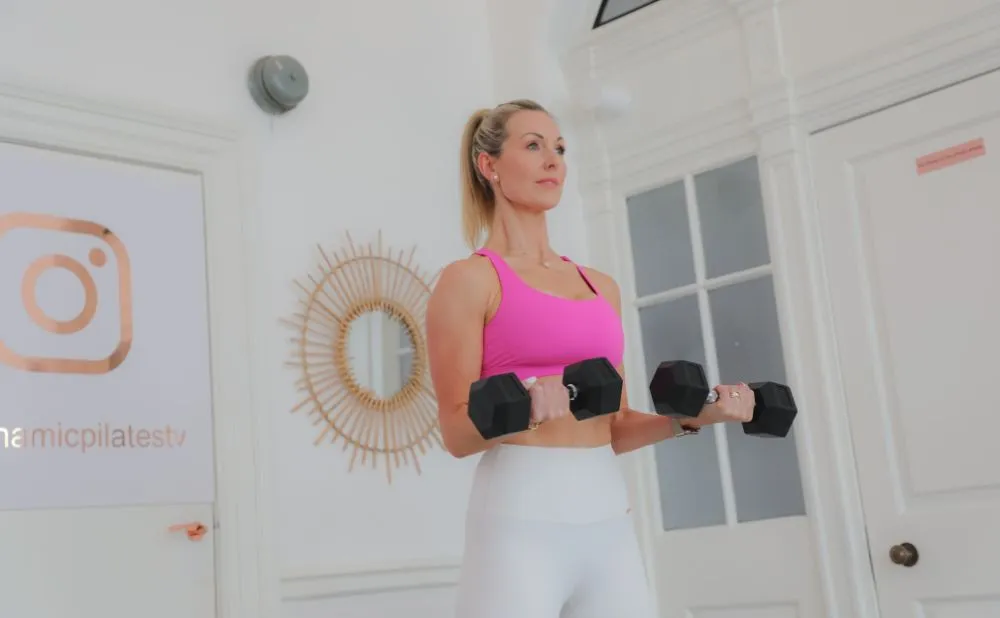As we approach our 40s and enter the perimenopausal phase, our bodies undergo a multitude of changes. These changes often include a decrease in muscle mass, a tendency to gain weight more easily, and shifts in hormonal balance. Therefore, switching up our training routine during this transformative time is not only essential for maintaining overall health, but can also significantly enhance the quality of our lives.
Research and my own personal experience suggests a combined approach to training, including weight training, HIIT, and Pilates, can play a pivotal role in helping us combat weight gain, retain muscle mass and even build muscle mass if done correctly, combined with a high protein diet. It can also help us regain control and face our 40’s with strength, resilience, and confidence.
So, lets look at these different forms of exercise and the benefits of each:
Weight Training for Muscle Preservation and Weight Management
As women age, a natural decline in muscle mass occurs, which can lead to a slower metabolism and increased weight gain. This is all due to our hormones and the decline of oestrogen. Incorporating weight training becomes crucial to counteract this loss. Lifting weights helps stimulate muscle growth, boost metabolism, and improve bone density. And I am not talking about 1kg or 2kg weights here, I am talking about actually picking up some heavy s**t! In fact these are the words of Dr Stacey Sims, a leading expert in women’s health and science. Check out her blog here https://www.drstacysims.com/blog/harness-the-perimenopause-power-window
Of course the reality of telling women to just ‘pick up heavy weights’ is not always as straight forward, as I know only too well myself. After having my third baby Jack five years ago when I was 40, I had a prolapse (I still have a prolapse FYI it’s just strengthened over the years) so, I simply could not lift too heavy, as it just worsened the symptoms. And of course there’s a shed load of other reasons why some women may not physically be able to lift heavy weights; injuries being another one of them.
That’s why it’s important to work with a trainer and gradually increase your strength over time. I personally use light to moderate weights (5-12kg- 10-24lbs max) when I doing my combined Strength HIIT Pilates classes, as these classes include more complex movements. And then I also do a focused weight session a couple of times a week, lifting heavy barbells and hex bars for example, focusing on more basic movements like squats and deadlifts and increasing load. So, anything up to around 50kg for me (although I know a lot of women can lift much heavier than that!) Both are good and effective, but it’s important to use weights that challenge you, whilst being able to maintain good form.
The Power of HIIT Training Over Cardio
High-Intensity Interval Training (HIIT) is popular for good reason. Check out my blog on HIIT training here. During perimenopause, hormonal changes can make weight management more challenging. HIIT workouts offer a time-efficient solution by combining bursts of intense exercises with short recovery periods. This approach not only torches calories but also enhances cardiovascular fitness and promotes the release of growth hormones which help increase muscle and bone strength. The hormonal benefits of HIIT can help regulate insulin levels, making it an effective strategy for managing weight and reducing the risk of type 2 diabetes. HIIT is favoured over prolonged cardio like running, as cardio has the tendency to raise cortisol levels (the stress hormone) which can lead to weight gain around the middle. Check out my blog on how cortisol contributes to abdominal fat.
Pilates: A Foundation of Strength and Resilience
It’s important to prioritise exercises that promotes core strength , flexibility, and injury prevention no matter what your age and I would say that’s even more the case post 40. Pilates, with its focus on controlled movements and precise muscle engagement, aligns perfectly with these goals. By targeting the deep stabilising muscles, Pilates helps improve posture, balance, and overall functional fitness. Furthermore, the mind-body connection nurtured in Pilates practice can aid in managing stress and keeping cortisol levels in check, which as we know from above, can help to reduce abdominal fat. Check out my blog on the benefits of Pilates.
Hormonal Harmony and Body Composition Goals
The hormonal fluctuations that accompany perimenopause can impact mood, energy levels, and overall well-being. Regular exercise, including weight training, HIIT, and Pilates, can help regulate hormone production and release, leading to improved mood and reduced stress. As you may know, exercises stimulate the production of endorphins, the “feel-good” hormones, which can counteract the mood swings and low energy often experienced during this phase of life. And the combined approach of Strength, HIIT & Pilates can help achieve the balance our bodies need post 40.
For more information on my Strength HIIT Pilates Challenges, sign up to my newsletter here.

